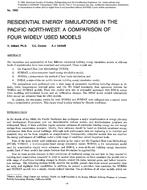Energy models assume that buildings live in an ideal world where people come and go as predicted, equipment shuts off consistently every night, everydamper and valve works perfectly, and weather does not take unexpected turns. In the real world, unique human beings occupy a building and use thespaces in unexpected ways, equipment and controls have ever increasing complexities, and building operators are stretched to keep both the buildingrunning and unique occupants happy. With all of these factors, it is not difficult to see why a building does not always match its theoretical energy model.While buildings will always have unique characteristics, there are a number of strategies that can help close the gap between the expected and realizedenergy performance. This includes performing detailed controls coordination during design, applying effective metering strategies, using monitored data todial in operation, and executing meaningful measurement and verification strategies for years to come.
Citation: 2017 Winter Conference, Las Vegas, NV, Conference Papers
Product Details
- Published:
- 2017
- Number of Pages:
- 8
- Units of Measure:
- Dual
- File Size:
- 1 file , 810 KB
- Product Code(s):
- D-LV-17-C029


